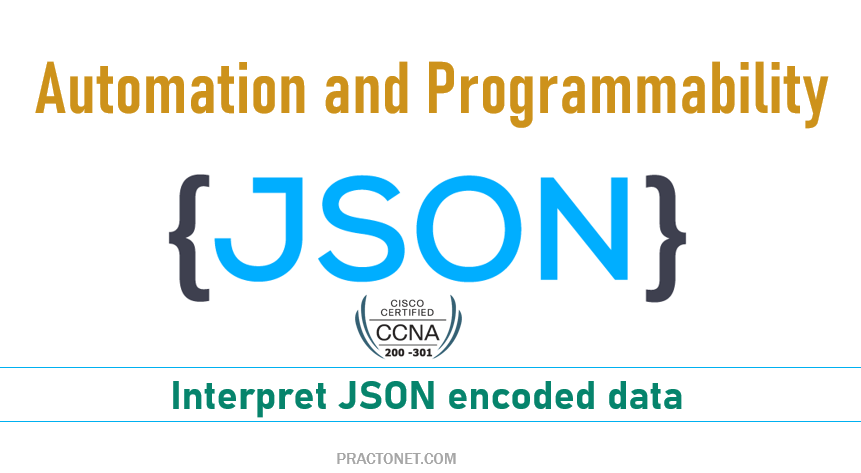In journey to become a modern network engineer with network automation skills, you will learn to understand several data serialization languages. Each data serialization language provides methods of using text to describe variables, with a goal of being able to send that text over a network or to store that text in a file. Data serialization languages give us a way to represent variables with text rather than in the internal representation used by any particular programming language.
Each data serialization language enables API servers to return data so that the API client can replicate the same variable names as well as data structures as found on the API server. To describe the data structures, the data serialization languages include special characters and conventions that communicate ideas about list variables, dictionary variables, and other more complex data structures.
Data Serialization Languages
You will hear about and eventually use several data serialization and data modeling languages the more you learn about network automation. While the currently we will learn only JSON, learning a few facts about some of the alternatives can be helpful to add a little context to your new knowledge of JSON. These different data serialization languages exist to meet different needs that have arisen over the years.
JSON
JavaScript Object Notation attempts to strike a balance between human and machine readability. Armed with a few JSON rules, most humans can read JSON data, move past simply guessing at what it means, and confidently interpret the data structures defined by the JSON data. At the same time, JSON data makes it easy for programs to convert JSON text into variables, making it very useful for data exchange between applications using APIs.
XML
The eXtensible Markup Language (XML) came later to make some improvements for earlier markup languages. In particular, over time web pages became more and more dynamic, and to make the pages dynamic, the files needed to store variables whose values could be changed and replaced over time by the web server. To define variables to be substituted into a web page, the world needed a markup language that could define data variables. XML defines a markup language that has many features to define variables, values, and data structures. Over time, XML has grown beyond its original use as a markup language. XML’s features also make it a useful general data serialization language, and it is used as such today.
Comparing XML to JSON, both attempt to be human readable, but with XML being a little more challenging to read for the average person. For instance, like HTML, XML uses beginning and ending tags for each variable. In the highlighted line in the example, the and tags denote a variable name, with the value sitting between the tags.

YAML
YAML Ain’t Markup Language (YAML) has a clever recursive name, but the name does tell us something. YAML does not attempt to define markup details (while XML does). Instead, YAML focuses on the data model (structure) details. YAML also strives to be clean and simple: of the data serialization/modeling languages listed here, YAML is easily the easiest to read for anyone new to data models.
Interpreting JSON
You can think of that skill and task with two major branches. First, even ignoring the syntax and special characters, anyone who knows the topic can probably make intelligent guesses about the meaning of many of the key:value pairs. For example, without knowing anything about JSON syntax, you could probably determine from your prior knowledge of Cisco routers and switches that the JSON in example lists two devices (maybe their hostnames) and a list of interfaces on each device.

You probably already know everything needed to do this kind of intelligent guessing. However, to perform the second type of task, where you analyze the JSON data to find the data structures, including objects, lists, and key:value pairs, you need to know a bit more about JSON syntax.
Interpreting JSON Key:Value Pairs
First, consider these rules about key:value pairs in JSON, which you can think of as individual variable names and their values:
- Key:Value Pair: Each and every colon identifies one key:value pair, with the key before the colon and the value after the colon.
- Key: Text, inside double quotes, before the colon, used as the name that references a value.
- Value: The item after the colon that represents the value of the key, which can be
Text: Listed in double quotes.
Numeric: Listed without quotes.
Array: A special value (more details later).
Object: A special value (more details later) - Multiple Pairs: When listing multiple key:value pairs, separate the pairs with a comma at the end of each pair (except the last pair).
Interpreting JSON Objects and Arrays
To communicate data structures beyond a key:value pair with a simple value, JSON uses JSON objects and JSON arrays . Objects can be somewhat flexible, but in most uses, they act like a dictionary. Arrays list a series of values. To begin, consider this set of rules about how to interpret the syntax for JSON objects and arrays:
- { } – Object: A series of key:value pairs enclosed in a matched pair of curly brackets, with an opening left curly bracket and its matching right curly bracket.
- [ ] – Array: A series of values (not key:value pairs) enclosed in a matched pair of square brackets, with an opening left square bracket and its matching right square bracket .
- Key:value pairs inside objects: All key:value pairs inside an object conform to the earlier rules for key:value pairs.
- Values inside arrays: All values conform to the earlier rules for formatting values (for example, double quotes around text, no quotes around numbers).
Example shows a single array in JSON format . Notice the JSON data begins with a [ and then lists three text values (the values could have been a mix of values). It then ends with a ].

While example shows only the array itself, JSON arrays can be used as a value in any key:value pair. Figure 18-12 does just that, shown in a graphic to allow easier highlighting of the arrays and object. The JSON text in the figure includes two arrays (lists) as values (each found just after a colon, indicating they are values).

Now think about the entire structure of the JSON data in figure above. It has a matched pair of curly brackets to begin and end the text, encapsulating one object. That object contains two colons, so there are two key:value pairs inside the object. When you think about the broader structure, as depicted in below figure, this JSON file has one JSON object, itself with two key:value pairs.

To drive home the idea of how to find JSON objects, consider the example shown in below figure. This figure shows correct JSON syntax. It has the following:
- There is one object for the entire set because it begins and ends with curly braces.
- The outer object has two keys (Wendells_favorites and interface_config).
- The value of each key:value pair is another object (each with curly braces and three key:value pairs).

Minified and Beautified JSON
So far, all the JSON examples show lots of empty space. JSON allows for whitespace, or not, depending on your needs. For humans, reading JSON can be a lot easier with the text organized with space and aligned. For instance, having the matched opening and closing brackets sit at the same left-offset makes it much easier to find which brackets go with which. When stored in a file or sent in a network, JSON does not use whitespace.
Most of the tools you might use when working with JSON will let you toggle from a pretty format (good for humans) to a raw format (good for computers). You might see the pretty version literally called pretty, or beautified, or spaced, while the version with no extra whitespace might be called minified or raw.





